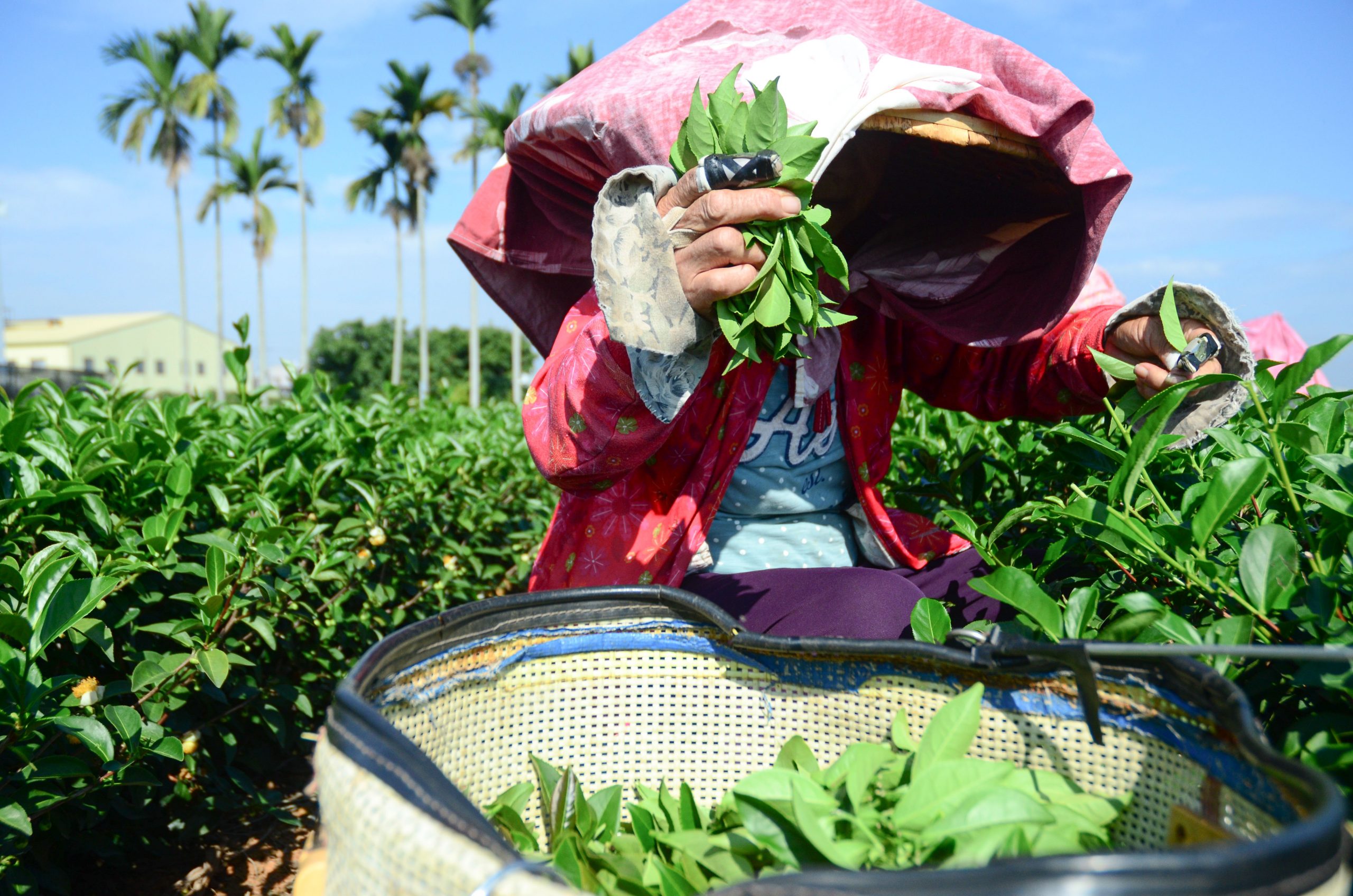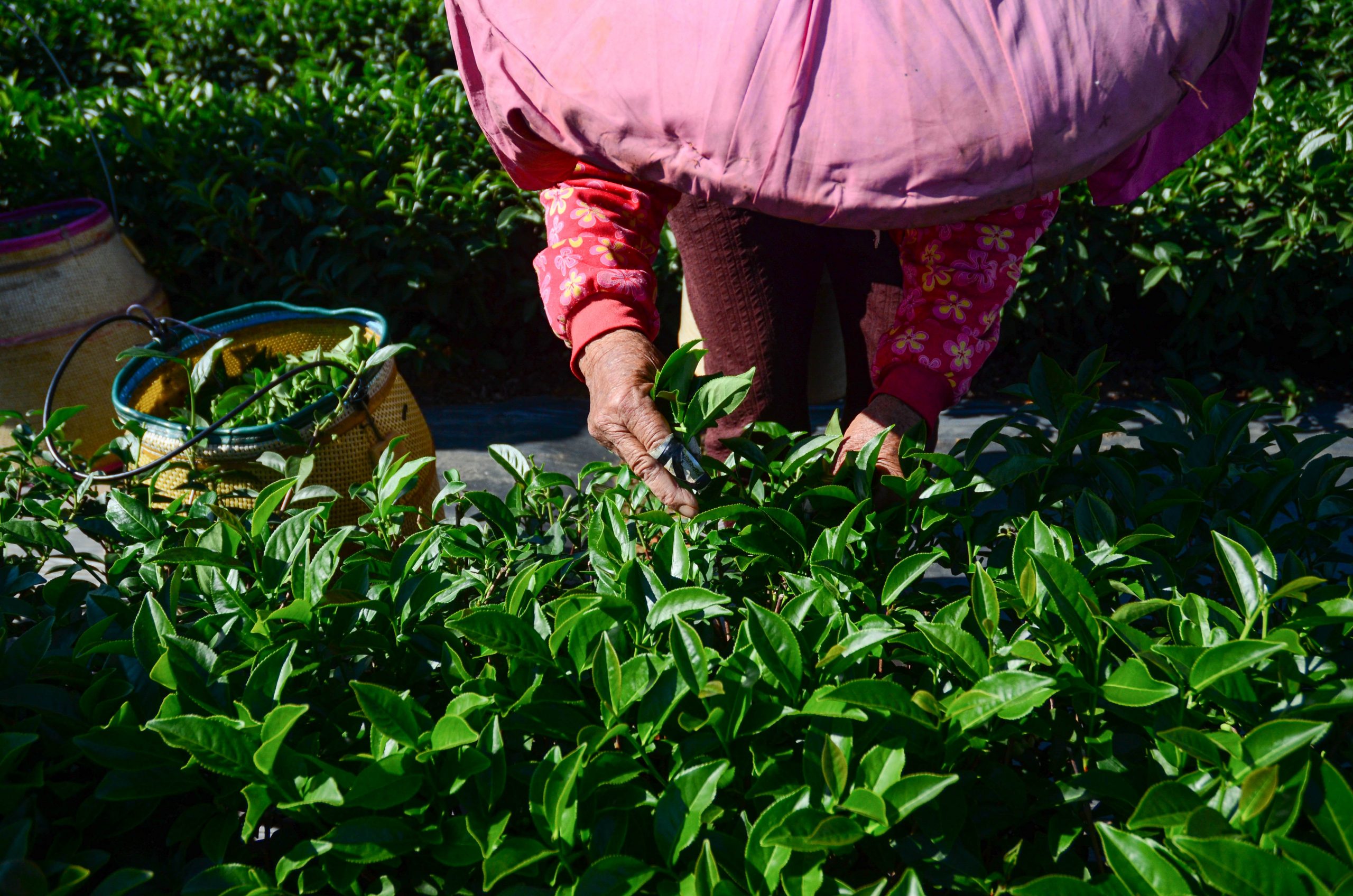
Finger Tea Story House Tea Plantation. Mingjing Township, Nantou. A woman handpicking Oolong Tea in the plantation, 480 m above sea level in Mingjing, the tea village. Photo Lizane Louw
I have always had love affairs with coffee and tea. The light, fruity, floral scents of tea suited my summers and springs and the thick, nutty, dark and rich chocolate aromas of coffee for my autumns and winters; I kept tea diaries about my adventures with tea
I travelled the world searching for spices and textile prints, flavours and tastes and decided to put together this series of tea stories in a collection, The Tea Diaries and other tea stories.
Growing up with tea
My tea stories and sensory journeys with tea started early. My first memory is from my kindergarten class in Cape Town. We used to sit lined up against a wall on the cold cement floors of the school, our little hands folded in our laps, waiting for a sterile metal cup of Rooibos Tea. The teas in these metal cups were milky white and sweet and had a strong earthy herbal smell.
Growing up in South Africa, we lived very “British”. There were always delicate white porcelain teacups with flowers and saucers and a beautiful teapot served on trays with cookies. Grandma and mom served tea the British way with sugar and milk. I have often wondered why we drink tea with milk and sugar, but it took many journeys to far-off places and living in Asia for eight years to figure out why South Africans in South Africa would drink tea the British way. South Africa has a long history with the Brits, which is also reflected in one of our favourite pastimes, drinking tea.
I remember my grandma’s heavy Imboya table, with white knitted doilies. The multi-pattern doilies were hand-stitched with white cotton yarn; they looked like crocheted lace. The whole set up so delicate. I was always scared to bump over a teapot or teacup accidentally. I never wanted to stain these soft hand-woven table and tray decorations. It was also Ouma who introduced me to this magical plant from the Cederburg mountains.
Tea, the British way
The Brits, of course, built their tea drinking traditions in Hong Kong, which was a British colony. As they say in Chinese, Nǎichá or milk tea, was the British tradition of drinking Chinese black tea with milk and sugar. This tradition spread over to all British colonies because, as we know, the Brits love their cucumber sandwiches and afternoon tea.
So black tea, the Lipton brand, with sugar and milk was my first real introduction to tea. Lipton, and Rooibos are made from the red bush, a fynbos species in Southern Africa. As I figured out years later, Rooibos tea was a robust and healthy herbal tea. Grandma introduced Rooibos and their medicinal value as herbal tea to me as I grew up visiting them on the farm in Clanwilliam. I was so impressed with her words and the healing properties of this red bush tea that I used to collect bags of Rooibos and infused this in my bathwater. Bathing in tea is still a tradition in my house today.

Tea legends and tea stories
I have often wondered where tea comes from. There are a lot of myths about the first cup of tea. Legends in India tell stories of Buddha, the first man to drink tea. The legends declare that during his seven years of sleepless contemplation, Buddha harvested a few young leaves from a nearby bush where he was meditating. The tea myths retell that Buddha plucked a few leaves from a nearby bush, clipped them and added the leaves to boiled water to infuse them. The story goes that this helped the Buddha fight fatigue when he began to feel sleepy. The legends refer to this bush as a wild tea plant.
The Chinese also have their legends and many stories in ancient manuscripts and historical texts.
Lu Yu’s book the “The Classic of Tea,” tells the story of Shen Nong, also described as the “Divine Farmer” or “God of Agriculture” in this classic book, translated from the Chinese, the “Cha Jing.”
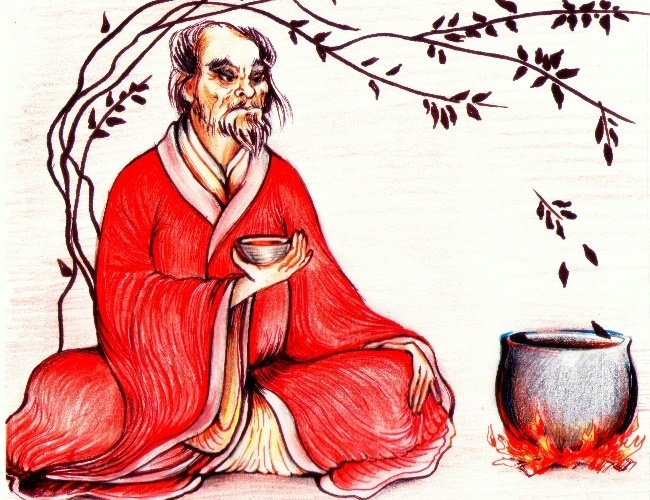
Shennong, the divine farmer who discovered tea first. Shennong (神农) translated means “Divine Farmer” or “God of Agriculture” in Chinese. Source: internationalteaexpert.com
Shen Nong
According to legend Shen Nong was sitting beneath a tree while his servant boiled the drinking water for dinner. Some of the leaves from a tree nearby fell into the water he was boiling, which coloured it brown. Sheng Nong was interested in this brown-coloured liquid, and he drank it. “The divine farmer” found the drink refreshing, and the myth goes that this is how tea was created. And of course, because tea is so delicious and refreshing, the word spread, and tea culture developed.
No one knows the actual origin of tea; as my interest in tea, coffee, herbs, and spices grew, I searched for the best teas and coffees on my travel journeys that took me to over 60+ countries.
Love affairs with coffee
My love affairs with coffee were winter affairs. From dark, black, thick instant coffee in the mornings on the farm, when we helped to milk the cows, to mud coffee in Tel Aviv on a hitchhiking trip with a friend, south, from Tel Aviv to Eilat in Israel.
The coffee in Spain was memorable, served in tiny cups, café con Leche, coffee with milk, in the morning market when I went to buy fresh bread, olives, tomatoes and smoked ham. The coffee was sweet and complimented the new smells of freshly baked bread and Mediterranean delicatessen in the morning markets in Santa Catalina, on the island of Mallorca.
I discovered Blue Mountain Coffee on visits to Jamaica. These coffees, of course, in my opinion, are the best in the world. The fascination comes from my love for reggae music and, of course, the Blue Mountains in Jamaica. Unfortunately, I only drove on the coast from Montego Bay, via Ochos Rios to Port Antonio; I saw the Blue Mountains in the distance. I saw enough to be drawn to the island and the heavy, nutty-chocolate, thick Blue Mountain Coffee. It has been over 20 years since I have been to Jamaica, but I still drink my Blue Mountain Coffee in winter. I got a syphon coffee maker and hand-ground coffee grinder for Christmas two years ago, so my journey of discovery of coffee continues.
Tea journeys and the tea diaries
The tea journeys and memories are the most memorable and were also the most intense learning experiences. I spend months travelling India, crossing the Indian continent in 3rd class train compartments cramped with other pilgrims, wallas and travellers. The chai wallah was announcing freshly brewed masala chai between stations: Chai, the Hindi word for tea.
Masala Chai and samosas. A hot milk tea drink and spicy vegetable snack combine the flavours of India. The smells are sweet, aromatic and spicy. Masala Chai, the aroma of herbs and spices, sweet and spicy and the milky taste combined with the vegetable dough triangles. These Indian traditions of food and tea were enough reasons for me to stay for months. The backstreets of Delhi, Jaipur and Varanasi still have the best Masala Chai; there are chai wallahs on every street corner, from Uttar Pradesh to Kerala.
Each region, of course, has their masala flavours and spices that spice up its peppery milk tea. India is sewage, incense, curry and masala chai.
Taiwan tea stories
My journeys with tea and coffee and my curiosity about herbs, spices and culture took me over the world for 20 years. I think I have visited over 60 countries; I stopped counting. These experiences have inspired some of my most enjoyable journeys, The Tea Diaries and other tea stories.
After arriving in Taiwan for the second time in 2016 after my extensive samosa, curry and masala chai trip through India, I discovered a more profound passion for tea.
It was in Taiwan, in a small village, one train stop from where I lived in Taoyuan, that I discovered the Chinese way of drinking tea.
The Chinese, and of course the Taiwanese way of drinking tea, challenged my whole perception and understanding of what it is to drink tea and why we drink tea. A real new world of discovery awaited at the bottom of a Pinming teacup.
The Indian way of drinking tea awoke my senses, and the tea was just a complimentary addition to my journey. Still, in Taiwan, the word tea established its meaning in my travel vocabulary.
Discovering a tea and ceramic village
The word tea is defined by the Oxford Dictionary as a hot drink made by infusing the dried crushed leaves of the tea plant in boiling water, so Chinese. It also defines “tea” as a light afternoon meal consisting of tea to drink, sandwiches and cakes, so British.
Living alone in a country where you don’t speak the language can sometimes be challenging, but these challenges frequently take you to unexpected places and on incredible journeys.
One such journey of discovery took me to Yingge. When I first heard the name of this renowned ceramic art village, I thought about the children’s story Heidi by Johanna Spyri. This story is about this small girl living in the Alps with her granddad and all her adventures. I thought that the name Yingge sounded like one of Heidi’s friends. She might have been the girl that milks the cows. I had no idea how a Swiss-German name ended up being a village name on a small Island south of China. I am still trying to figure that out.
Yingge then is where my love for tea developed, and my serious research into tea culture and teas began.
Yingge, a sensory tea experience
Yingge is a short train ride from Taipei. It is located on the Dahan River in southwestern New Taipei City. The most famous street, Old Street, is a walk away from the Yingge train station. Tourists are welcomed to Yingge with English street signs and directions, so it is hard to get lost, but it is easy to lose yourself.
Upon arrival in the village for the first time, I was utterly taken with the mosaic work on walls, artworks depicting teapots and mythical figures in all colours and shapes. The Japanese Colonial architecture is eye candy.
I have often jumped on the train to Yingge to stroll through the cobbled old street. The smell of freshly baked baguettes and bread hangs thick in the air on Sunday afternoons. An old lady sits and plays a round ceramic flute in a small Buddhist temple down the street. This is the soundtrack of Yingge. Yingge is an art and culture experience that awakens all senses.
I would stroll down these cobbled streets often and imagine myself being somewhere in Europe. The village seems quite out of place here in the Far East.
The tea culture in Yingge
I fell in love with Yingge and its tea culture for many reasons. First, the village’s name reminded me of my European descent, and then the ceramics and the application of ceramics to religion, daily life and architecture make this art village stand out. Everything is functional and decorative. A certain kind of Zen to the place is tough to put into words. It is a peaceful and creative place. Little did I know that my visits to this village would inspire many tea stories.
On one such adventure to Yingge, I met Nichol, a tea master. Nicole runs a teashop at the bottom of Old Street called AllForTea. I discovered this tiny little teashop by chance on a stroll one Sunday.
Drinking 50-year-old tea
That Sunday afternoon, I sat with Nichole for three hours, taking part in a traditional tea ceremony, not knowing what I was experiencing. I had my first taste of 50-year-old tea. I can imagine how clean the earth must have been when this tea was harvested. It tastes like clean dirt: earthy, heavy and woody.
After I left the teashop that day, I felt somewhat lightheaded, the colours around me were very vivid, and I felt my nose and chest opening in a way I can’t describe. I think I was tea drunk and “tea high” the feeling was euphoric, but I wasn’t sure if it was the tea or if it was just me being swept away with the tea experience.
Visiting the teashop regularly and observing what Nicol did during the tea ceremonies made me more curious, I asked her numerous questions that she explained in her broken English. Upon one of these visits, I decided it was time to invest in my tea utensils. I bought a tiny black ceramic teapot with red cotton string tying the lid to the tiny handle. I also bought a brick of 12-year-old tea. This brick is a round, compressed tea block; it looks like a flat cake. You chisel the brick with a special tea knife and tea needle. This silver tea needle I got as a gift from Nicol, and I set out and bought all these unique utensils I needed after that because I felt that I needed that tea Zen feeling in my own life.
I started reading up more about Yingge, ceramics, Buddhism, Zen and art of tea. I found a place where all these natural elements of Buddhism, the minimalist aesthetic portrayed in art and household utensils, comes together. All around the village, there are masters, masters in art, masters in cooking and of course, the tea masters.
The Gongfu way of making tea
I decided that this is the aesthetic that I wanted for my life. The tea experiences and stories from this tiny village with the name of a Swiss-German girl profoundly impacted me.
Time stops when you are drinking tea the right way. Or at least this feels like this is the right way because of the ritual involved. Drinking Gongfu tea is a complex process.
One Thursday in late November 2018, whilst battling with my master’s degree, I had a chance to revisit Yingge, this time with someone that also wanted to have a real tea experience. The village was a must-visit destination at least once a month, just for inspiration for my art and, of course, to spoil myself with ceramics for my house.
So, during some serious writing for said master’s thesis in journalism, I had this visitor from South Africa. I took her on a walk through Yingge and needles to say we ended up in the teashop with the tea master. After about an hour, Nicol showed me the way to a table set up for Gongfu, with a Gongfu tea set. I finally learned how to set this up for a ceremony. It was an extraordinary moment in a tiny little teashop, drinking teas I had never tasted before. I finally shared the ancient ritual this friend had only heard of in my stories. I was doing my first Gongfu tea ceremony under the eyes of my first tea master.
Gongfu, if translated, means “making tea with skill.” I decided I want to master the art of tea making.
Until that moment, even though I was performing the ritual with precision from observation, I wasn’t quite sure what I was doing. It was still just an everyday ritual for me. My Chinese is poor, and I am left to discover much meaning from observation.
Becoming a student of the tea leaf
I kept burning my fingers with the tiny little teapot, the Gawain. This is a handleless little pot used to infuse the tea. As my learning continued as a student of the tea leaf, I learned later, just like in martial arts, there were various ways to hold this tiny little pot so that you don’t burn your fingers. I instinctively used a yin position in my hand not to burn my fingers. I realised that this little teapot or teacup would be a teacher. With the Gawain, my education in Gongfu and tea started.
There is something about time that stands still when you focus on making a proper cup of tea. It also helps if you have High Mountain Oolong tea. Probably the most fragrant tea I have ever smelled.
In a tea-tasting ceremony, you will also come across this tiny little fragrance cup. The tea ritual is quite complex, but one part of the ritual is just smelling the tea. High Mountain Oolong tea smells like a mix of jasmine, mango, grapes, peach and fresh grass. With every pour, the tea becomes lighter. You can infuse the tea leaves ten times. It is a magical experience to watch a tea master wash tea leaves and the tiny ceramic teapot that goes with this special ceremony.
Teapot adventures
On that visit to the teashop, when I did my first ceremony, we decided we wanted to go in search of the perfect little teapot. I shared my love and passion for tea with the visitor, and we decided to set out to Yingge a week later on a teapot adventure, searching for the perfect little tea ceramic tea infuser.
We were rummaging through a variety of shops lining the cobbled street. I created pictures as we walked through the shops to visually document the teapot search.
The first Gawain’s we found were meticulously designed. I have never seen such good lines and functionality on a piece of ceramic art. These tiny teapots were Zen masterpieces, tea instruments that can stand on their sides, balancing against gravity. They were green, the colour of fresh olives. I was mesmerized. It had a hefty price tag, and I walked away from this set with a heavy heart.

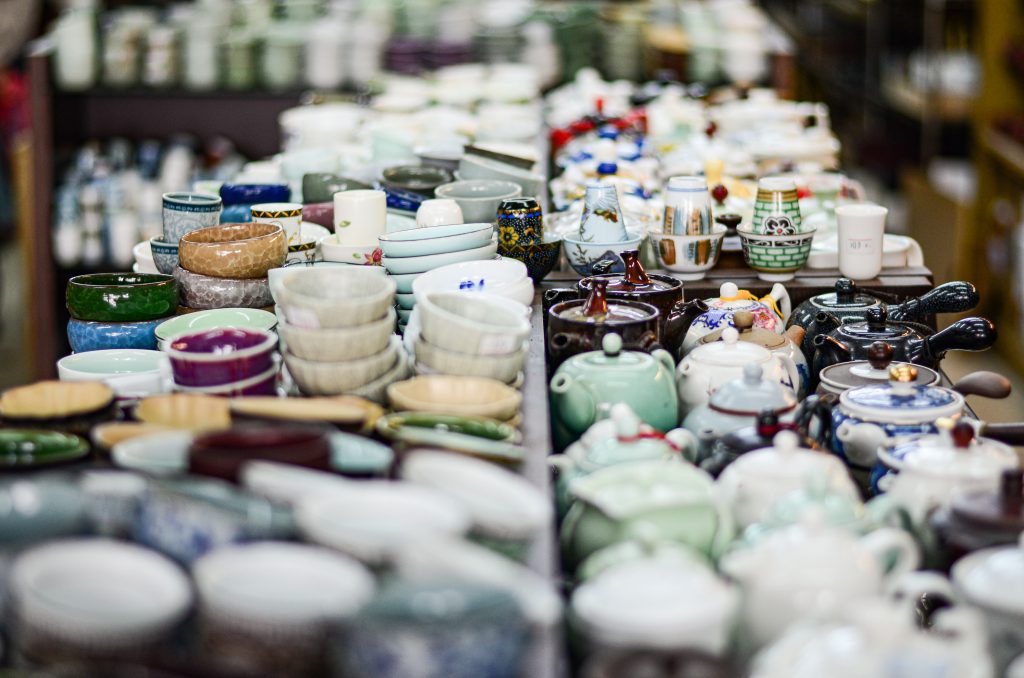

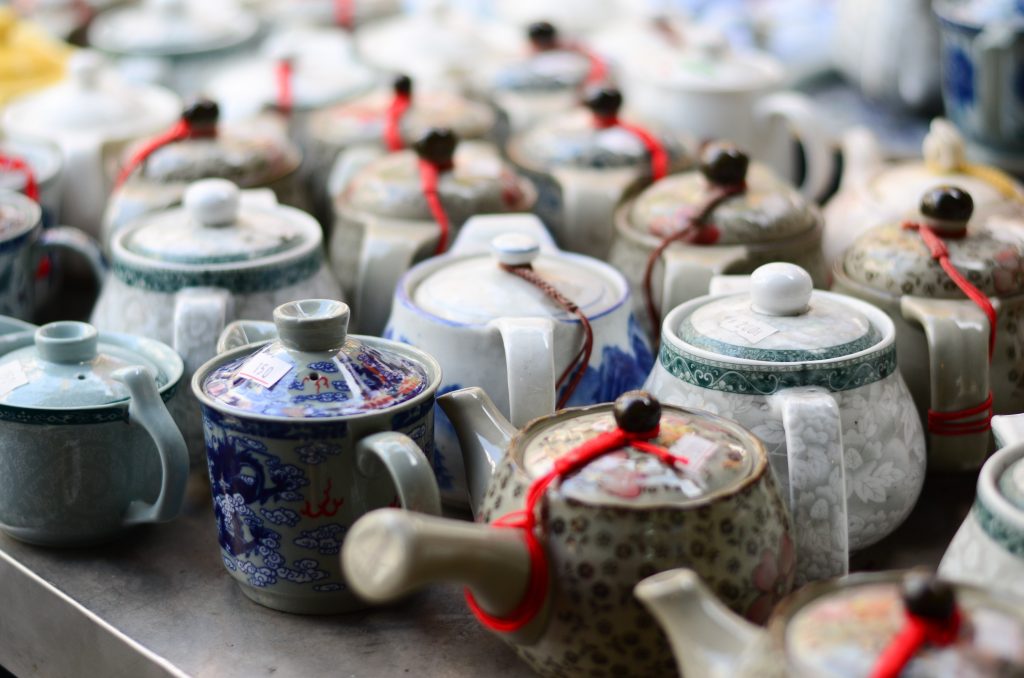











In search of the perfect tiny teapot
I kept searching the whole day, having the perfect little minimalist Buddhist tea in mind. I walked into each shop, touched and “oohed” and “aahed” at all the tiny teapots I saw. Before heading home, I finally found a little shop stocked with the white ceramics I was looking for. I bought the Gawain, the filter, the tea pitcher and pinming cups. The tiny little teapot arrived in my life in the form of white ceramics, simple lines, with a lip that curved at the top. The pingmin cups echo the design of the Gawain. It is so simple but so profound. When you drink the tea, it feels as if your lips curl around the edge of these tiny teacups. Perfection.
We headed to the Buddhist shop on the corner of Old Street. Monks from the nearby temples buy their wooden eating utensils and wooden bowls, trays and wooden tea utensils in this shop.
I am stoked up on everything I needed. I am ready for my adventures with Gongfu Cha.
The impact this experience has had on me is rather difficult to put in words. I suggest that anyone who loves tea and art should visit Yingge. Anyone open to discovery, not only of art and visual aesthetics but how the Buddhist lifestyle and a simple tea ceremony can teach one to be present, mindful, and in the now.
All of this, a world of discovery, in a tiny cup of tea made from the best loose-leaf tea from the high mountains of Taiwan.
If you want to read more, read the Tea Diaries and other tea stories.


